In the Southern United States, South America, and Central America, there is bird whose unique traits have earned it nicknames like “Snake Bird,” “Devil Bird,” and “Water Turkey.” (1) In the Eastern Hemisphere, members of this bird’s family are referred to as “Darters.” In the West, the sole representative of this group is the Anhinga. Although Anhinga is the given name of the American representative of the Darter family, all Darters share the scientific genus name of Anhinga. The American “Darter” has the honor of carrying the scientific name Anhinga anhinga.
With turkey-like fanning tails, wings that are often outstretched for the sake of thermoregulation, a long slender neck which is responsible for the “Snake Bird” nickname, and a sharp bill shaped like a dagger, the Anhinga is a striking figure most often spotted along the edges of lakes, ponds and waterways. (2)
Anhingas are majestic and strange, their name originates from the language of the indigenous Tupi people of the of the Amazon River Basin region. In the Tupi language, “Ayinga” is the name of an evil forest spirit. (3) It is possible that this is why the Anhinga is sometimes referred to as the “Devil Bird.”
Despite this unfortunate alias, Anhingas are no more demons than they are turkeys or snakes. They are, however, adept hunters, fascinating and unusual birds, and striking inhabitants of waterways and wetlands. Read on to learn about the incomparable Anhinga with all of its strange and wonderful traits!
Anhinga Symbolism and Meaning
Anhingas represent mystery, hidden things, patience, and precision. Unlike most diving birds, including even their closest relatives, Anhingas do not just watch for fish from above the water. Instead, they swim. As they stalk their prey through the rippling water, their long slender necks zig and zag along the surface, closely resembling the undulating movements of snakes. It is this hunting style which is responsible for the “Snake Bird” epithet. (4)
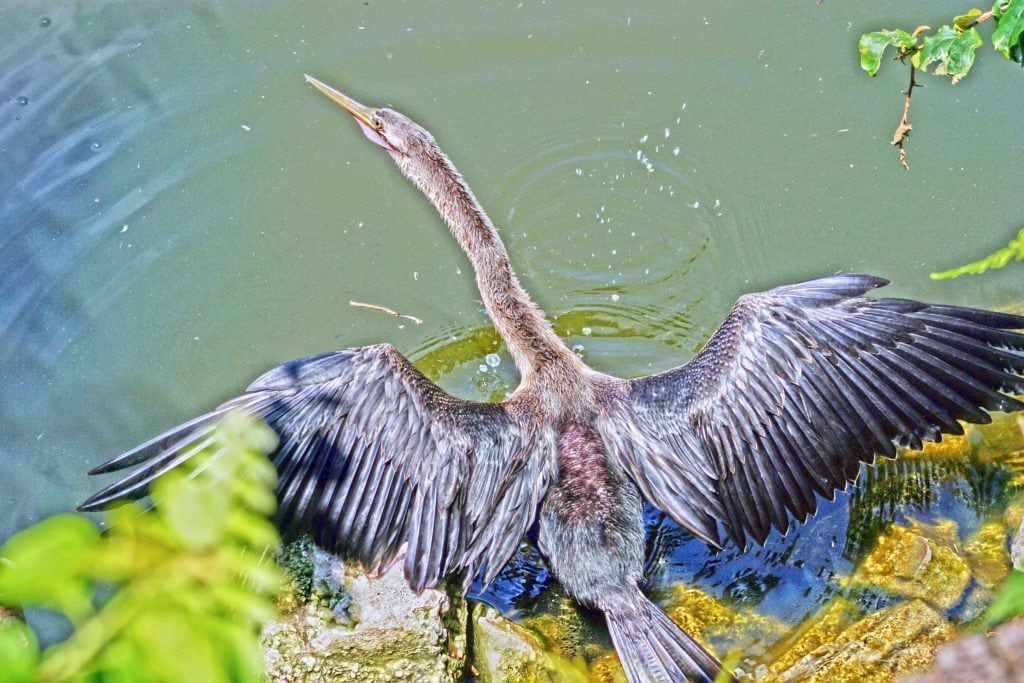
Furthermore, the Anhinga does not merely snatch its prey within its long pointed bill. Rather, the Anhinga spears its unsuspecting meal. By opening its mouth, the Anhinga is able to create two puncture wounds in an instant and can then feast on its impaled fish dinner. (5)
So, Anhingas may represent adaptability, or the ability to thrive under abnormal circumstances and in many different environments. In addition, Anhingas may represent sharpness, speed, and dexterity. The brutal efficiency with which these birds secure their meals is awe-inspiring.
One possible meaning for the Anhinga is greed. Anhingas are related to and fairly closely resemble cormorants. Cormorants have long been maligned by fisherman for their alleged greed and propensity to devour fish. Many defend cormorants, insisting that in many places cormorants eat more invasive fish than they do desirable commercial fish. (6)
In John Milton’s Paradise Lost, the cormorant appears as a symbol of avarice. (7) On the other hand, cormorants have an ancient history of assisting fisherman by catching fish and returning them. There is even a limited history of Anhingas being used in this manner of fishing. So, Anhingas may represent greed or cooperation and generosity depending upon one’s perspective.
Anhinga Native American Symbolism
The Anhinga, according to the indigenous Tupi, is connected with dark magic and the mysterious forces of the forest. Perhaps, the original Tupi who named this bird were unnerved by its snake-like appearance whilst swimming. To the uninformed, Anhingas in action may even resemble shape-shifters.
In many Native American circles, though, birds are powerful sources of healing and guidance. Anhingas are sometimes seen as messengers bearing wisdom from the great spirits. Some cultures may also interpret this bird as a water or sky spirit, connected with the weather and with storms. (8)
Anhinga Christianity Symbolism
The classic pose of the Anhinga, wings outstretched, may be due to this bird’s unique feathers. Unlike many other water birds, whose feathers wick away water, the Anhinga spends a fair amount of time swimming. So, the feathers of the Anhinga can’t trap too much air, otherwise these birds would be unable to sink underwater quickly. Many believe, then, that the Anhinga’s pose is due to the need to dry wet feathers. It may be more likely, though, that Anhingas assume this posture as a means of thermoregulating. Anhingas may need the sun’s energy to warm up their bodies after all of that swimming. (9)
In any case, this wings outstretched pose has been compared to the shape of the crucifix, the most holy symbol in all of Christian iconography. Thus, the Anhinga can be seen as a symbol of faith, sacrifice, forgiveness, and Christianity itself.
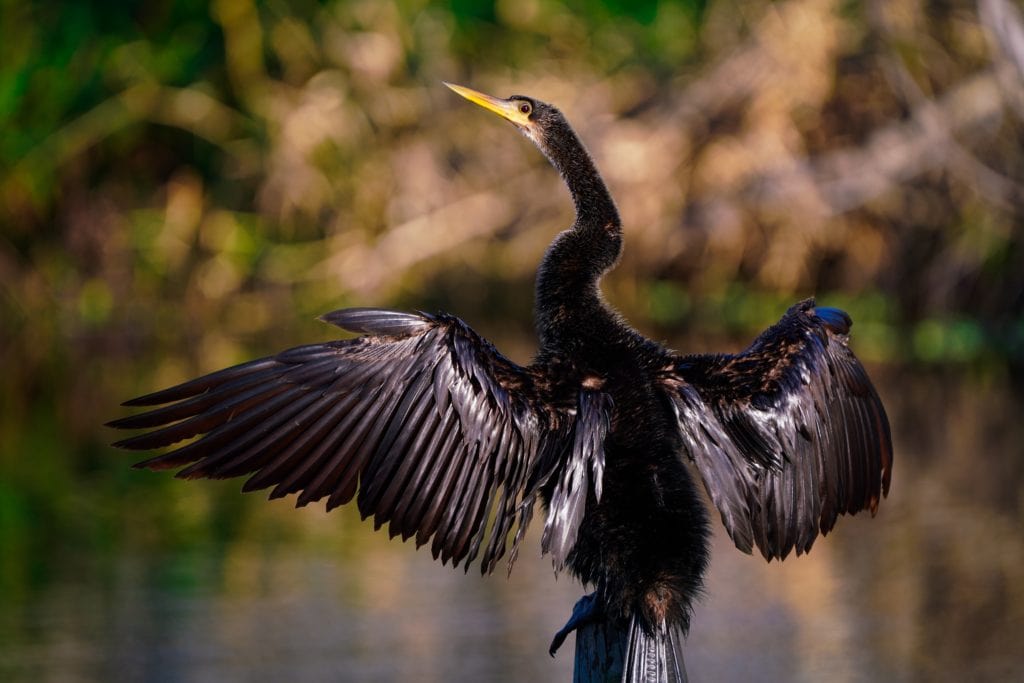
Consequently, this holy cruciform shape clashes with the Anhinga’s reputation as a serpent-like or even devilish bird. Snakes are often connected with the devil, meaning that the “Snake Bird” and “Devil Bird” nicknames would both connect the Anhinga to the enemy of all believers. Most Christians, though, believe that all of nature is God’s creation and reflects his love. Thus, the Anhinga as a reminder of God’s hand in nature and of Jesus’s sacrifice on the cross is far more potent than any derogatory nickname.
Anhinga Celtic Symbolism
In Celtic traditions, Darters and cormorants are often connected with death and ill omens. They may be seen as symbols of the unforgiving whims of the mighty ocean which can turn against a fisherman or sailor at a moment’s notice.
Anhinga in Dreams
Dreaming of an Anhinga can represent something lurking within the subconscious, as the Anhinga lurks in the water hunting for fish. In many cases, an Anhinga in a dream may present an opportunity to learn or to correct one’s course.
Dreaming of a swimming Anhinga may be a sign that one feels out of place or is struggling to adapt to an unfamiliar environment. Though the Anhinga is an excellent swimmer, it is not built to live a purely aquatic life. Additionally, Anhingas sink quickly because their feathers do not repel water. So, an Anhinga dream may represent a flaw that can be turned into a talent. Weaknesses often provide us with unique strengths by pinpointing areas where we can grow and learn. If the Anhinga’s feathers did repel water, then it would not be able to sink silently and quickly in order to hunt. (10)
Additionally, an Anhinga dream may indicate that something in the dreamer’s life is not what it appears to be. Anhinga’s may, at times, look like snakes, but they are most decidedly not reptiles. Be on the lookout for situations where you may have made a hasty or unnecessary judgment based upon appearances.
Anhinga Encounters and Omens
Anhingas are known to be somewhat secretive compared to their more boisterous cormorant relatives. For this reason, an Anhinga encounter can be a very lucky or special experience. Encountering an Anhinga is quite possibly a sign that one is on the right track.
Furthermore, Anhingas are masters of their craft, their hunting skills stand out even amongst other fishing birds. An Anhinga encounter may represent efficiency, work ethic, and passion. It may be a reminder to put in the work to master the skill which matters most to you.
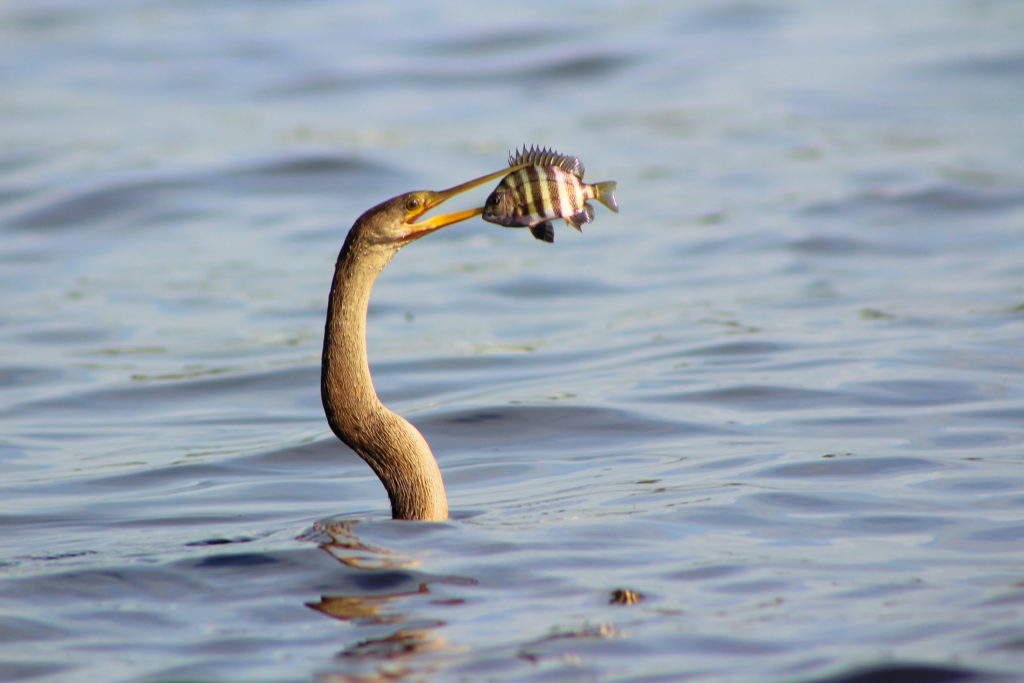
Encountering an Anhinga in the classic cruciform pose can be a sign of faith. It may be a reminder to engage with yourself spiritually and nurture your own spiritual curiosity by studying the natural world.
The cruciform pose, however, can also represent warmth, renewal, and light. Seeing an Anhinga in this pose may be a reminder to open yourself up to joy and let light into your heart. Take time to heal as the Anhinga takes time to warm its body after a hard day’s work.
Anhinga in Mythology & Folklore
Anhingas don’t often appear in mythology, however related birds often do. To determine the mythological symbolism of the Anhinga, cormorants are also worth addressing.
South American Mythology:
As stated above, the Tupi people use the word “Anyinga” to refer to an evil forest spirit. This character was one of dark magic and demonic malice. I suspect that the Anhinga’s unusual shape, especially whilst observed swimming through the water, contributed to this association. In the water, Anhingas are serpent-like and a bit confusing to look at. Perhaps this is why the Anhinga was thought to be connected to a demonic entity lurking in the Amazonian wilderness.
Japanese Mythology:
Because cormorants and Anhingas share in the history of “Ukai” or cormorant fishing, these birds are seen as friends of mankind and good omens for fisherman. Anhingas are not used in Japanese cormorant fishing, but have been used for this fishing method in a few small communities in different parts of Asia. (11)
Greek Mythology:
In Greek mythology, Darters and Anhingas are not a major presence. It is worth noting, however, that the god Apollo is referred to as Apollo the “far-darter.” (12) This epithet probably has a double meaing. Referring both to Apollo’s prowess as an archer and his connection with oracles which allow him to predict the future. The “far-darter” nickname is certainly not connected with Anhingas. And yet, the incredible vision and accuracy of the Anhinga as a hunter aligns well with Apollo’s characterization. Furthermore, the Anhinga’s striking gaze could easily lead one to believe that these animals possess forbidden knowledge. Perhaps this is why the Tupi connected Anhingas with dark and mysterious forces.
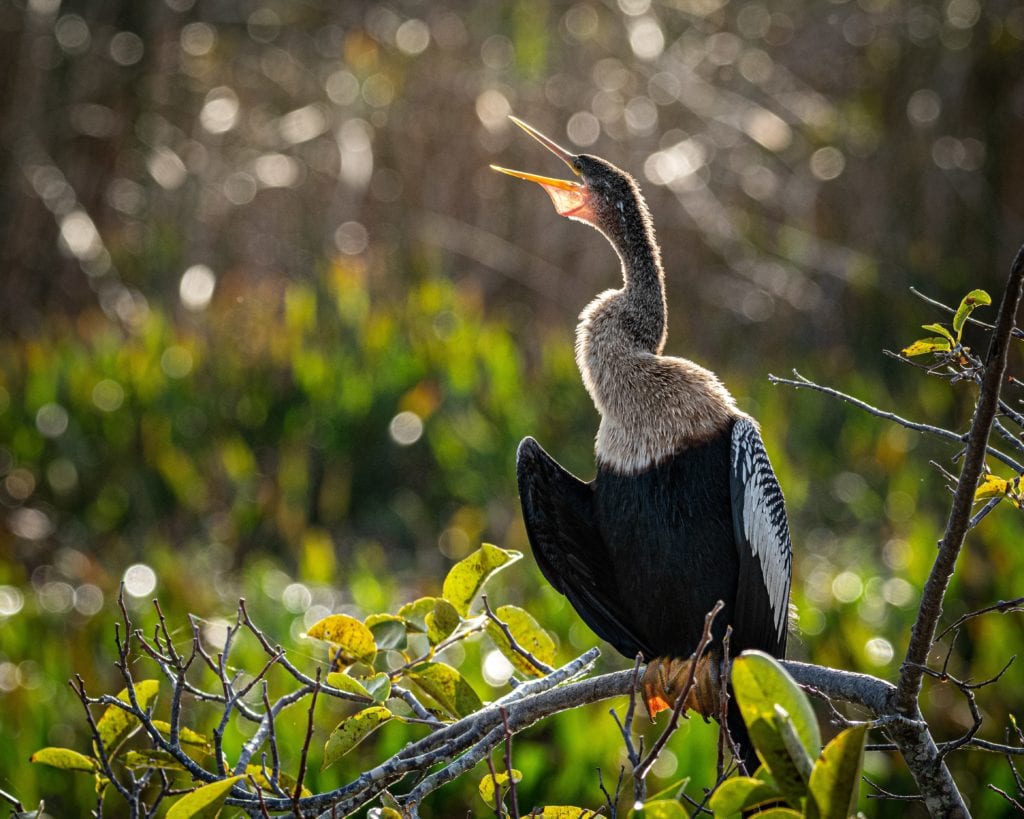
Additionally, the god Hermes is described as moving similarly to a cormorant in Homer’s Odyssey. As previously stated, Anhingas and cormorants are relatives and bear a noticeable resemblance to one another: “On to Pieria he stepped from the upper air, and swooped down upon the sea, and then sped over the wave like a bird, the cormorant, which in quest of fish over the dread gulfs of the unresting sea wets its thick plumage in the brine. In such wise did Hermes ride upon the multitudinous waves.” (13) Thus, Greek mythology may have connected Anhingas with speed and dexterity or with the messenger god Hermes who embodies these traits.
Anhinga Spirit Animal
If the Anhinga is your spirit animal, then you are likely both stoic and eccentric. People with the Anhinga spirit animal don’t easily open up to others. Preferring solitude, people with the Anhinga spirit often appear reserved, shy, or even boring in group settings. Dive a bit deeper, though, and the Anhinga spirit is one of passion, dedication, and open-mindedness.
People with the Anhinga spirit animal may be uncomfortable in social settings, but when it comes to trying new things otherwise, they are fearless explorers. Easily adapting to most circumstances, and happy to take the plunge and leave their comfort zones, Anhinga spirits love to test their limits. Do not assume, however, that the Anhinga spirit animal is reckless or frivolous. Although this may seem to be the case, the Anhinga spirit animal tends to be very grounded and sober when it comes to responsibilities.
Anhinga Totem Animal
The Anhinga totem animal represents focus. People with this spirit animal are capable of channeling an incredible inner fortitude when it comes to accomplishing important tasks. Under stress, people with the Anhinga totem neither bend nor break. Instead, they flow with the current, never taking their eyes off of the prize.
The single-minded determination of the Anhinga totem animal may be intimidating. To their peers, the Anhinga totem may seem almost Machiavellian. On the contrary, people with the Anhinga totem are usually motivated by the sheer joy that accompanies honing a talent which one dearly loves.
Anhinga Power Animal
The Anhinga power animal is connected with healing, rejuvenation, and light. People with the Anhinga power animal, perhaps due to their aforementioned focus, are introspective and put a lot of effort into self-knowledge. Through this, they often become experts at healing emotional distresses and renewing the strength of the spirit.
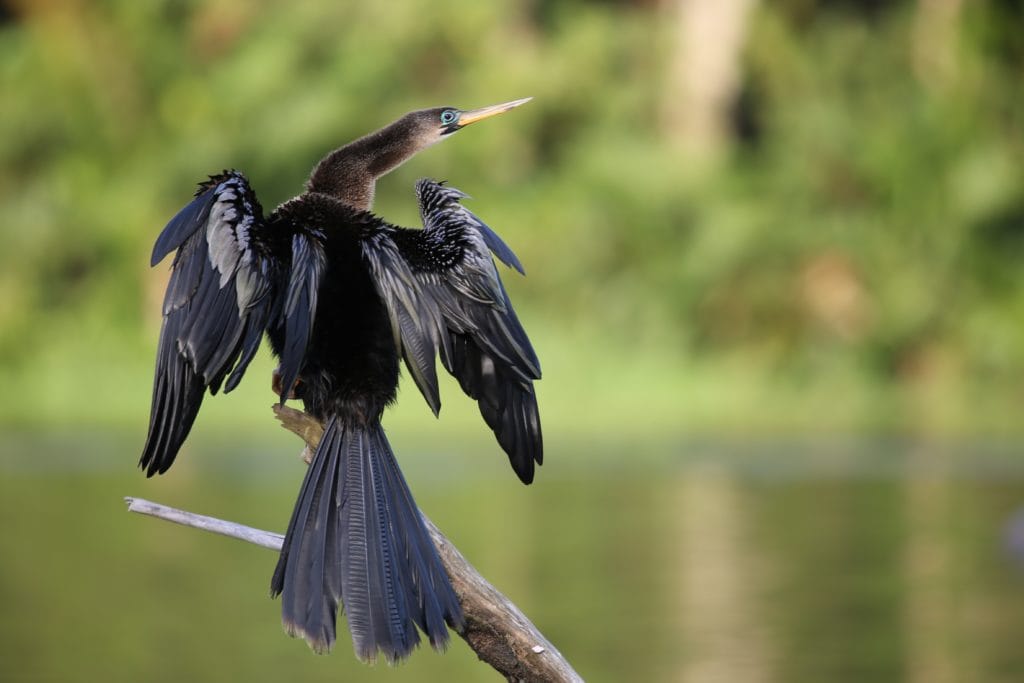
For the Anhinga power animal, healing is a joyful process through which the individual is enriched with newfound understanding. People with the Anhinga power animal may take special pride in sharing this process with trusted loved ones.
Anhinga Tattoo Meaning
An Anhinga tattoo may be chosen to represent the feeling of being misunderstood, as Anhingas are perceived as serpentine and demonic in some circles, and sacred and holy in others.
An Anhinga tattoo may also represent focus, precision and dexterity. An Anhinga would be an appropriate tattoo choice for an individual who loves fishing, as these birds represent the very pinnacle of angling.
Conclusion
Each time I write about a new bird, I fall in love with birds and birding all over again. Before researching the Anhinga, I was not aware of its evil reputation in some circles. How poetic that the “Devil Bird” is also one of the birds most recognized for its crucifix pose? To be quite honest, I could never perceive a bird as evil or demonic. It seems quite obvious to me that birds are pure ambassadors of nature and the beauty that it shares with us.
The Anhinga, though, reminds me of nature’s secrets. The mysterious places where humans can never go. When the Anhinga effortlessly glides through a crystal clear river, I wonder what that must feel like. I wonder how powerful and agile the Anhinga must feel when each of its sinuous muscles moves on command within the space of an instant to skewer a fish. I wonder how warm and content the Anhinga must feel when, wings outstretched, it opens its body up to the sunlight and allows its feathers to dry. To me, that is the essence of the Anhinga’s magic, and it is the essence of the magic of birds.

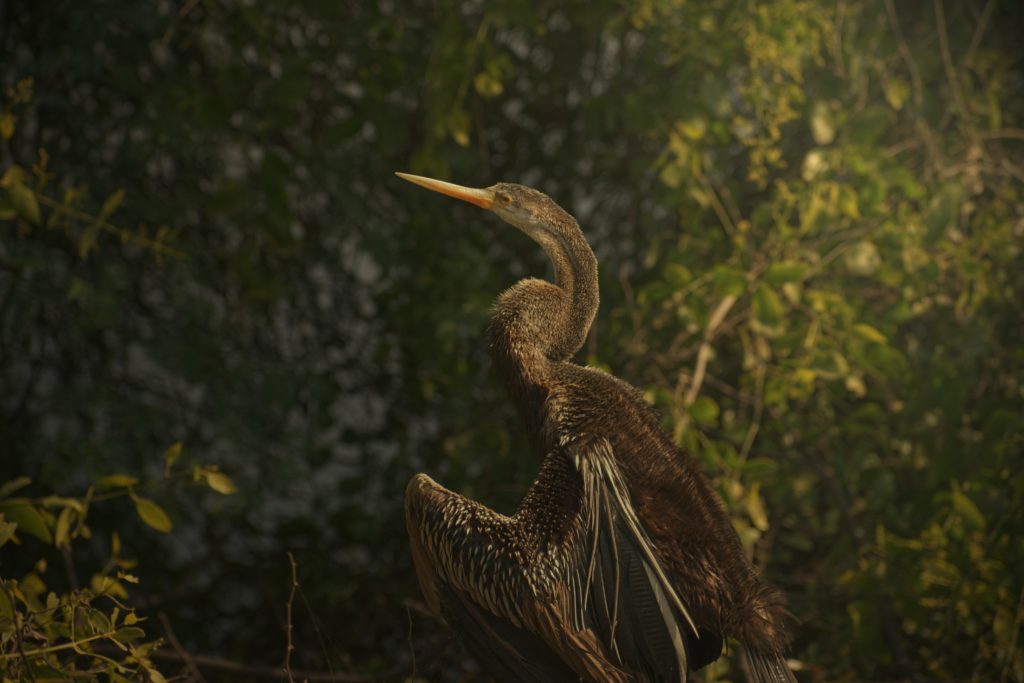
I had a long encounter with one today, and your article was the only one I found that gave me the perspective I was seeking
Beautifully written. Thank you
Thank you for reading!!!
— Hailey Brophy
Writer @ WorldBirds
One thing that I’ve never seen mentioned for why the anhinga might be called the devil’s bird is their call. They sound like a sinister kazoo, which could be pretty menacing if you’re not expecting it! I personally think they sound hilarious and magical, and love hearing them.
That’s very interesting! Maybe that is part of the name origin. They’re such fascinating birds with so many interesting traits! Thanks for reading my article and for sharing your thoughts!
— Hailey Brophy
Writer @ World Birds